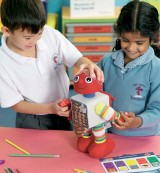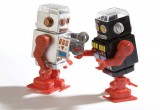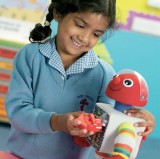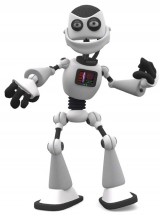Watch the sparks fly as children tackle Pie Corbett’s robot inspired literacy project...
Watch the sparks fly as children tackle Pie Corbett’s robot inspired literacy project…
Start off with a warm up activity. Ask the children to imagine what tasks they would ask a robot to perform for them and list the answers on the board. What might be helpful?

The Child’s Ideal Robot Could
The children can become ‘poetry robots’. Everyone needs a piece of paper. On this they create five columns which are labelled from left to right as shown.
| Adjective | Noun | Adverb | Verb | Noun |
|---|---|---|---|---|
| Calm | Pylon | Carefully | Drifted | Newspaper |
| Curious | Letter | Cautiously | Coughed | Escalator |
| Sunny | Mouse | Reluctantly | Wedding | Ring |
| Greedy | Cap | Precisely |
Gossiped | Book |
| Jealous | Pen | Calmly | Hooted | Watch |
| Scarlet |
Tractor | Wearily | Packed | Eyeball |
Give the children a few minutes to fill the first column with six adjectives. They then fold the paper over so the next person cannot see what they have written and pass it on.
Now everyone fills column two with six nouns. This is then folded and passed on, repeating the procedure until everyone has a piece of paper which looks something like the table to the right.
The poetry robots now create six sentences. The rule is that the children have to use the words in the line as it is written - they cannot swap them over. This should produce random associations and rather surreal but pleasurable sentences.
It is helpful to use prepositions to link ideas (above, below, beside, on, in, about, at, into) and extra description can be added in for the final noun, eg:
The children could all sketch their own robot. Ask them to label their machine, describing what each of the different parts can do. This might look rather like a Heath Robinson design - for example, the children’s robots might have a dispenser for serving up completed homework, an extendible arm for offering cups of tea and a games console for when the master is bored.
Ask the children to create a passport for their robot. This should include details of name, address, characteristics, hobbies, main features, materials, number of buttons/levers and their function, how long the batteries last, what to do in emergency malfunction, and how to maintain the robot.
 Prepare the children to hold a debate and then produce a piece of discussion writing around the theme, ‘Are Robots a Good Thing?’ Some of the children should begin to build up lists of reasons why robots are helpful.
Prepare the children to hold a debate and then produce a piece of discussion writing around the theme, ‘Are Robots a Good Thing?’ Some of the children should begin to build up lists of reasons why robots are helpful.
They might want to think about their uses in medicine where robots perform intricate key-hole surgery, how robots can make living easier, as well as their use in transport, creating energy and space exploration. The other children will need to provide reasons why robots are not necessarily a ‘good thing’. This might involve using examples of where machines have failed, causing disasters, or have been used to create destruction.
They might also look ahead and offer warnings about the role of robots in the future. Both groups will need to rehearse what they have to say using the language of debate.
| The Team That Agrees | The Team That Disagrees |
|---|---|
| Many people believe… | On the other hand… |
| We have various reasons for… | However… |
| Our first reason… | Alternatively… |
| Furthermore… | Whilst some people think…. Many also believe… |
| In addition… | It is not right to suggest that… |
| It has been found that… | Furthermore… |
| These facts mean that… | Also, we want to argue that… |
| Without… | The key factors for believing this are… |
| Another key point… | In addition… |
| ...because… | Importantly… |
| Finally… | Finally… |
 Ask pupils to write a robot story using the simple template below in which the main character owns a robot which malfunctions. This leads to some problems. In the end the robot is captured and mended, so order is restored. Begin by asking the children to think about their main character, the robot this character owns and what its main functions might be. Having done this, they should decide what will go wrong and invent one, at the most two, incidents involving the malfunctioning robot. Finally, they have to decide how the robot will be captured so that it can be mended. As a finishing touch, the children can come up with several new features that are added to the robot whilst it is being mended. I would start by asking the children to map out their ideas on a story map, story board or by using a flowchart or story grid. They should avoid anything too complicated, remembering that they are creating a series of events that will have to be written. Simplicity will help children to concentrate on the quality of their writing. Use the model story to help the pupils write their own.
Ask pupils to write a robot story using the simple template below in which the main character owns a robot which malfunctions. This leads to some problems. In the end the robot is captured and mended, so order is restored. Begin by asking the children to think about their main character, the robot this character owns and what its main functions might be. Having done this, they should decide what will go wrong and invent one, at the most two, incidents involving the malfunctioning robot. Finally, they have to decide how the robot will be captured so that it can be mended. As a finishing touch, the children can come up with several new features that are added to the robot whilst it is being mended. I would start by asking the children to map out their ideas on a story map, story board or by using a flowchart or story grid. They should avoid anything too complicated, remembering that they are creating a series of events that will have to be written. Simplicity will help children to concentrate on the quality of their writing. Use the model story to help the pupils write their own.
| Main character owns a robot. | Shara and her robot Gussie are helping her father at the market stall on Saturday morning. |
| The robot is functioning normally. | They are putting out everything on the stall and arranging the display. |
| The robot malfunctions. | Gussie makes strange noises and then starts to throw things around. |
| Things go wrong due to Gussie steals something from the malfunctions. | Gussie steals something from another stall and runs away. |
| The main character manages to capture the robot. | Shara tracks Gussie down and manages to grab him. |
| The robot is mended Gussie is mended and comes back - with extra features. | Gussie is mended and comes back with an inbuilt ice cream function! |
 Drama activities can help children to build up ideas and explore the fictional world in which their story takes place. To start off this session, use the story that I have written about Gussie (see right). Begin by reading it through several times. Then carry out the following tasks:
Drama activities can help children to build up ideas and explore the fictional world in which their story takes place. To start off this session, use the story that I have written about Gussie (see right). Begin by reading it through several times. Then carry out the following tasks:
a. Having pushed back the tables and chairs, everyone pretends to be in role at the market - some children will be stall-holders whilst others can role-play being shoppers. The role-play involves the moments just after the incident with the robot malfunctioning. Everyone chats and gossips. Then freeze the class and ask them to sit.
b. Hotseat Shara, Timo and Shara’s father about what happened.
c. Now, in role as journalists, some of the class interview people from the market about what happened. Prepare a short news bulletin and broadcast to the class.
d. In small groups the children then role-play the final scene when the old Professor brings the robot back home.
Share This Tale Of Mechanical Mischief With The Class…
 Saturdays were always a special day for Shara. Not only was there no school but also it was market day. Shara’s father loaded up his old van and they drove down to the market. Everyone was there. Timo’s father owned the stall next to theirs and he was already setting out his fruit and vegetables. Timo grinned at Shara as he piled up shiny red apples, huge yellowy melons, fingers of bananas and the sweetest smelling strawberries.
Saturdays were always a special day for Shara. Not only was there no school but also it was market day. Shara’s father loaded up his old van and they drove down to the market. Everyone was there. Timo’s father owned the stall next to theirs and he was already setting out his fruit and vegetables. Timo grinned at Shara as he piled up shiny red apples, huge yellowy melons, fingers of bananas and the sweetest smelling strawberries.
Gussie knew exactly what to do. Shara pressed the remote control and he began to buzz and whirr, lights flashing as he warmed himself up. A few seconds later, Gussie trundle round to the back of the van and began unloading the rolls of cloth. Shara’s father was famous for his beautiful cloth. Women travelled many miles to buy from him, for not only did he take good care of the cloth but also he was an honest man and only asked for a fair price.
Gussie purred from the back of the van round to the stall and placed the rolls of cloth in neat rows - silks of every colour in the rainbow glowed in the morning light. It was just as Gussie appeared with a long roll of white cotton that it happened. He stopped, gave off a high-pitched squeak and his red warning light flashed. Shara gasped! The warning light had never flashed before and she knew that it meant Gussie was malfunctioning. Something was wrong. Suddenly, Gussie lowered the roll of cloth and charged at Timo’s stall like a battering ram. The next thing they knew, potatoes and pomegranates were sent flying and the ground was covered in cucumbers and carrots. Gussie seemed to be cackling as he charged down the market stalls, sending early customers flying. What was more, he had a huge green watermelon balanced on his head!
Shara chased after him. Dodging disgruntled shoppers, she pursued the little robot as quickly as she could. Gussie was usually so quiet and helpful, that it was distressing to see him behaving like this. He was whooping and squeaking, grabbing at handbags and bumping into people. Eventually, she saw him slip under a stall selling CDs and old videos. Shara crouched down. she could see Gussie in the half-darkness, making strange bleeping noises like a puppy whimpering. He seemed to have run out of steam. Shara scooped Gussie up, apologised and took him back to her father’s van.
It was two weeks later that Gussie returned from the laboratory of Proteus Robots. As a prototype robot that was part of the government’s ‘home experiment’, to discover whether robots could fit into family life, Shara was entitled to all updates as well as regular servicing. The old Professor who ran the laboratory handed Gussie over. “Here you,” he said, smiling at Shara. “As good as new - and I’ve added an extra feature. He’ll serve your favourite ice cream once a day as a treat. But you’ll have to keep his tank topped up with cream. The frosting machine is working splendidly. I don’t think we’ll be seeing young Gussie till his next check-up.” Gussie bleeped a welcome, his eyes staring straight at Shara. She was sure that she saw him wink!
i. Repetitive Movements
Put the children in pairs facing each other. One pupil is the leader and the other is the robot. The leader has to train the robot how to move. Begin with simple actions, then move on to miming everyday events such as brushing teeth, washing your face or setting a table. The robot has to copy the leader.
ii.Just Following Orders
One child is selected to be the robot who has to do exactly what he is told. Another child volunteers to command the robot. Give the commander a task such as, ‘get the robot out of the room,’ or ‘get the robot to put on a pullover’. The commander then gives instructions and the robot has to do precisely what is said. So, if the commander says, ‘turn to the right’, the robot spins round to the right endlessly turning! This game makes a good precursor to a session on instructional writing.
If you would like to share this story with your class on the whiteboard or view more of our Pie Corbett resources, please click here.
Supporting parents with maths
Ace-Maths
How To Use Books To Help Children Cope With Life
Ace-English
Reorganise your music room
Ace-Music
